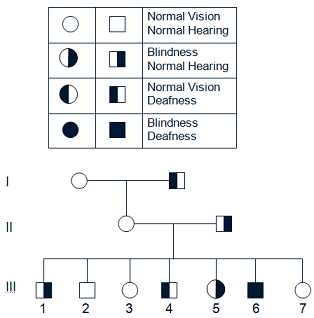What are the genotypes of the original parents in this cross
1. Erythropoietic Protoporphyria (EPP) is a defect in heme biosynthesis that is inherited with the X-linked dominant allele E. The X-linked recessive allele e does not contribute to EPP. Colon cancer susceptibility is inherited with the autosomal recessive allele c. The autosomal dominant allele C prevents colon cancer.
a. Martin has both EPP and colon cancer susceptibility. His wife Megan does not have either condition. Megan’s father has colon cancer susceptibility. Out of 4 children born to Martin and Megan, what is the probability that 2 will be daughters with EPP who do not have colon cancer susceptibility?
b. What is the probability that the first child born to Martin and Megan will be a son with colon cancer susceptibility who does not have EPP and their second child will be a daughter with EPP who does have colon cancer susceptibility and their third child will be a son who has neither EPP nor colon cancer susceptibility?
c. Dylan has neither EPP nor colon cancer susceptibility. His wife Destiny has EPP and colon cancer susceptibility. Dylan’s mother has colon cancer susceptibility. Destiny’s father does not have EPP. Out of 5 children born to Dylan and Destiny, what is the probability that at least one will be a son with both EPP and colon cancer susceptibility?
d. For Dylan and Destiny, what is the probability that their first child will be either a son with colon cancer susceptibility who does not have EPP or a daughter who has neither EPP nor colon cancer susceptibility?
2. A prototrophic Hfr strain of E. coli with the genotype trp+ purB- pyrC+ is conjugated with an F- strain with the genotype trp- purB+ pyrC-. The trp gene is known to enter last. The following numbers of recombinants were isolated:
|
trp+ purB– pyrC– |
0 |
|
trp+ purB+ pyrC+ |
44 |
|
trp+ purB+ pyrC– |
132 |
|
trp+ purB– pyrC+ |
224 |
Draw a genetic map that shows the order in which these genes are arranged and the distances between them.
3. Four different Hfr strains of E. coli transfer their genes in the order given below:
|
Strain 1 |
Gene Markers |
A |
B |
F |
C |
|
|
Entry Time (min) |
5 |
36 |
54 |
59 |
|
|
|
|
|
|
|
|
Strain 2 |
Gene Markers |
B |
D |
E |
F |
|
|
Entry Time (min) |
3 |
12 |
42 |
62 |
|
|
|
|
|
|
|
|
Strain 3 |
Gene Markers |
F |
B |
A |
C |
|
|
Entry Time (min) |
2 |
20 |
51
|
74 |
|
|
|
|
|
|
|
|
Strain 4 |
Gene Markers |
D |
A |
E |
|
|
|
Entry Time (min) |
7 |
29 |
37 |
|
Using these results, construct a linkage map of the circular E. coli chromosome. Express the gene distances in transfer time (minutes) between adjacent pairs of genes.
4. A female rabbit with rickets, hemophilia and a tail was mated to a male rabbit that did not have rickets or hemophilia but lacked a tail. The F1 females were all wild type, that is, not having rickets or hemophilia but having a tail. The F1 males had rickets, hemophilia, and tails. A cross of F1 females to F1 males produced the following offspring in the F2 generation:
|
Phenotypes |
Males |
Females |
||
|
No rickets |
Hemophilia |
Tail-less |
39 |
0 |
|
Rickets |
No hemophilia |
Tail |
43 |
55 |
|
Rickets |
Hemophilia |
Tail-less |
1 |
0 |
|
No rickets |
No hemophilia |
Tail |
2 |
190 |
|
No rickets |
Hemophilia |
Tail |
11 |
60 |
|
Rickets |
No hemophilia |
Tail-less |
16 |
0 |
|
Rickets |
Hemophilia |
Tail |
197 |
195 |
|
No rickets |
No hemophilia |
Tail-less |
191 |
0 |
a. What are the genotypes of the original parents in this cross? Write each genotype to show which alleles are linked together on the same chromosome.
b. What are the genotypes of the F1 males and females? Write each genotype to show which alleles are linked together on the same chromosome.
c. Draw a genetic map showing the distances between these genes. Express the distances in map units.
d. What is the degree of interference?
5. In humans, deafness (d) and blindness (b, due to the disease retinitis pigmentosum) are determined by recessive alleles at X-chromosome loci that are 26 map units apart. Consider the pedigree shown below.
a. What are the possible genotypes for individual III-3? What is the probability for each possible genotype?
b. What is the probability that individual III-3 will have a son who is both blind and deaf?
c. What are the possible genotypes for individual III-5? What is the probability for each possible genotype?
d. What is the probability that individual III-5 will have a son who is both blind and deaf?

